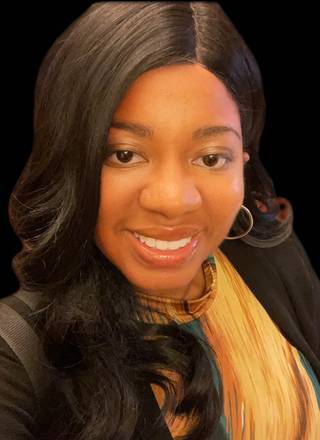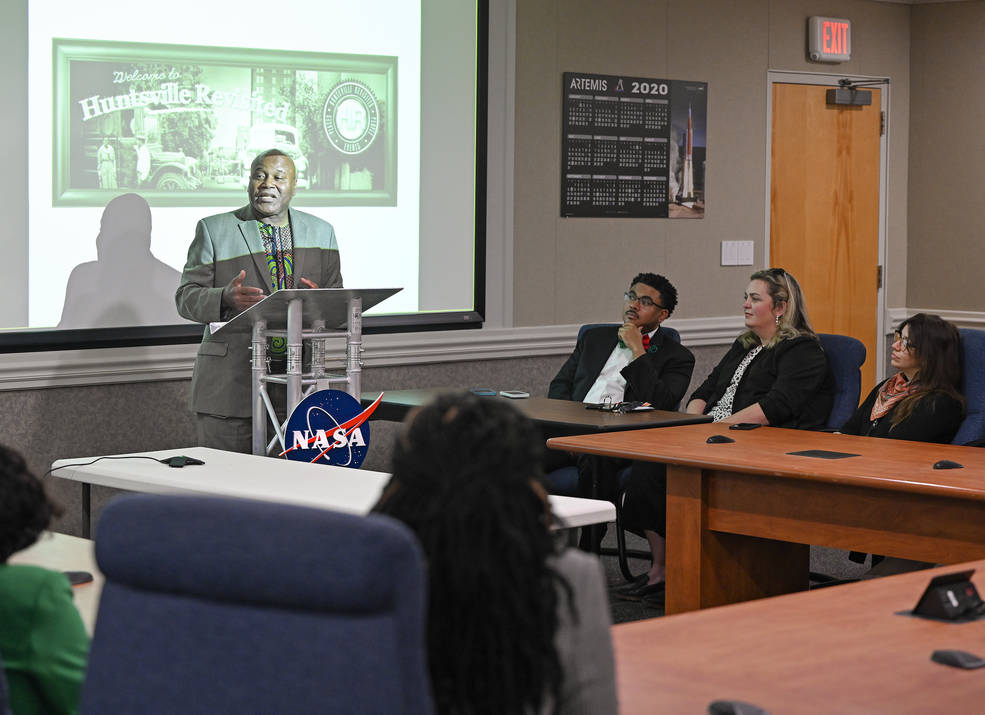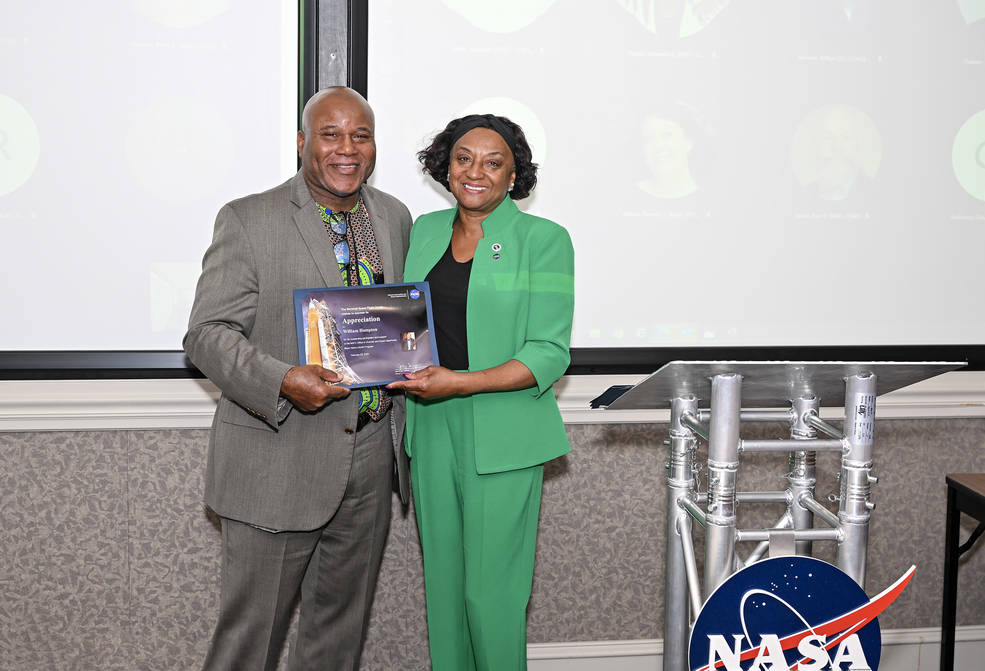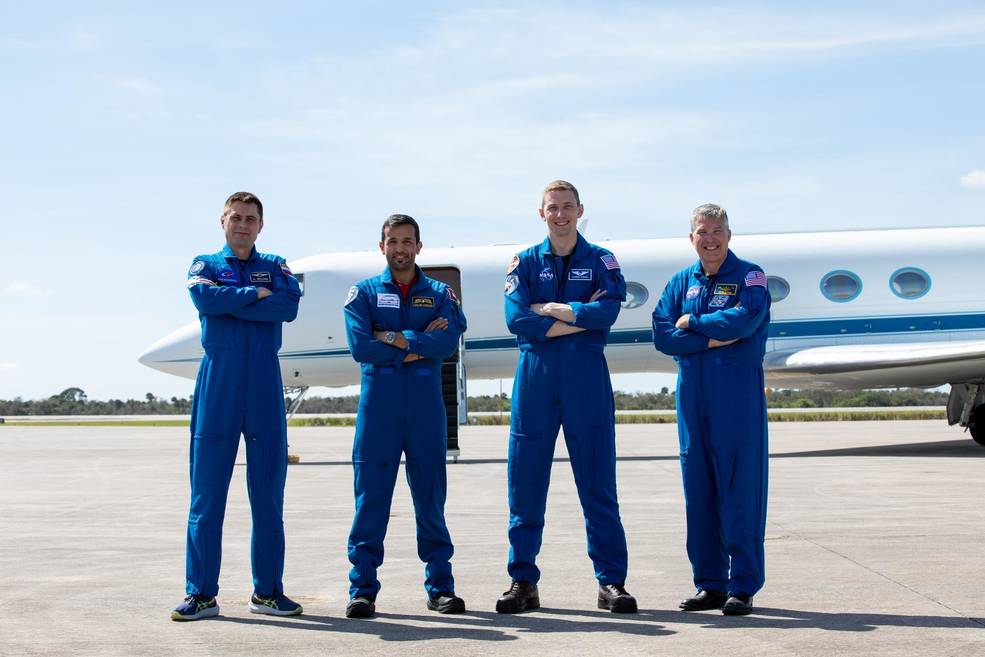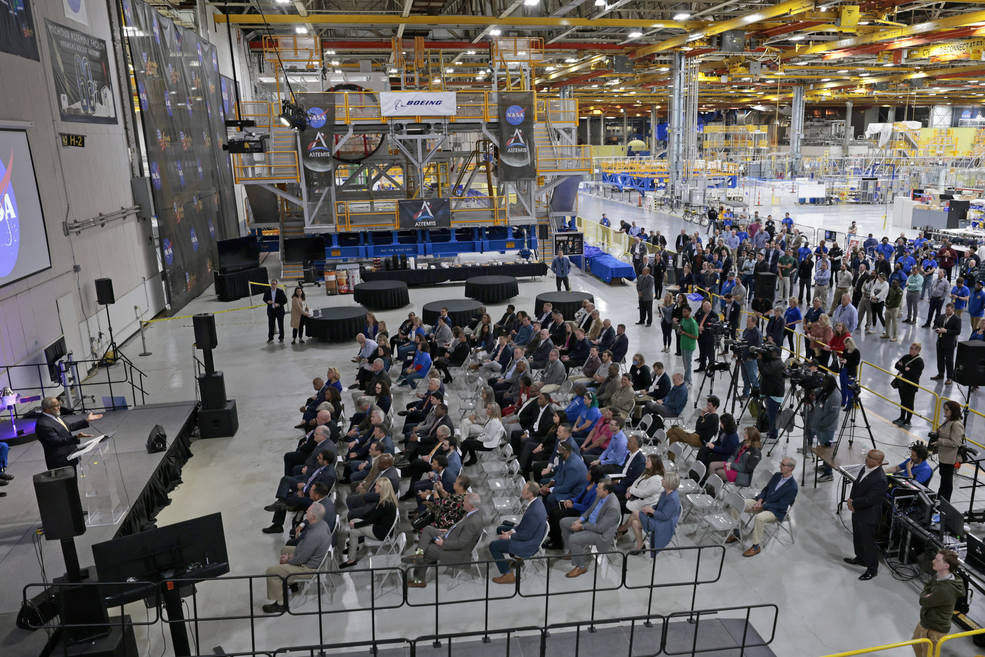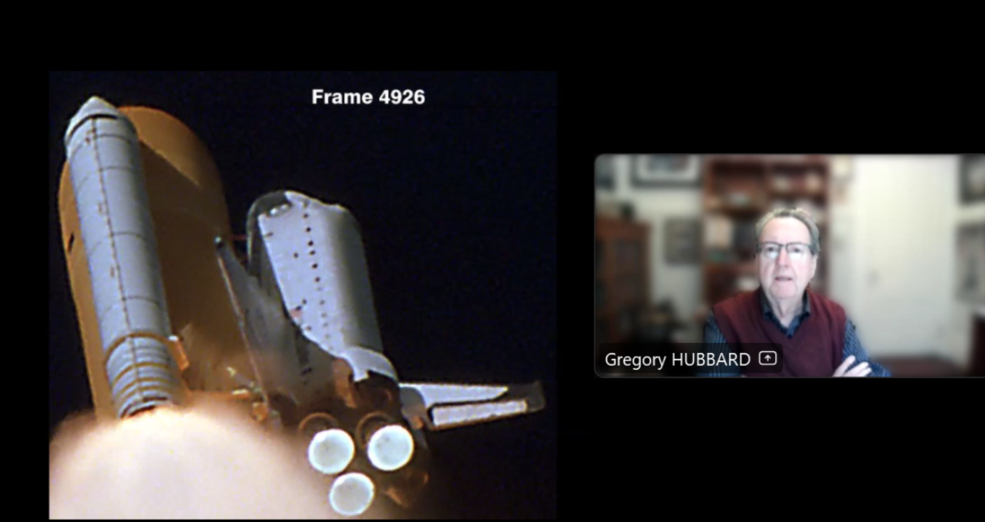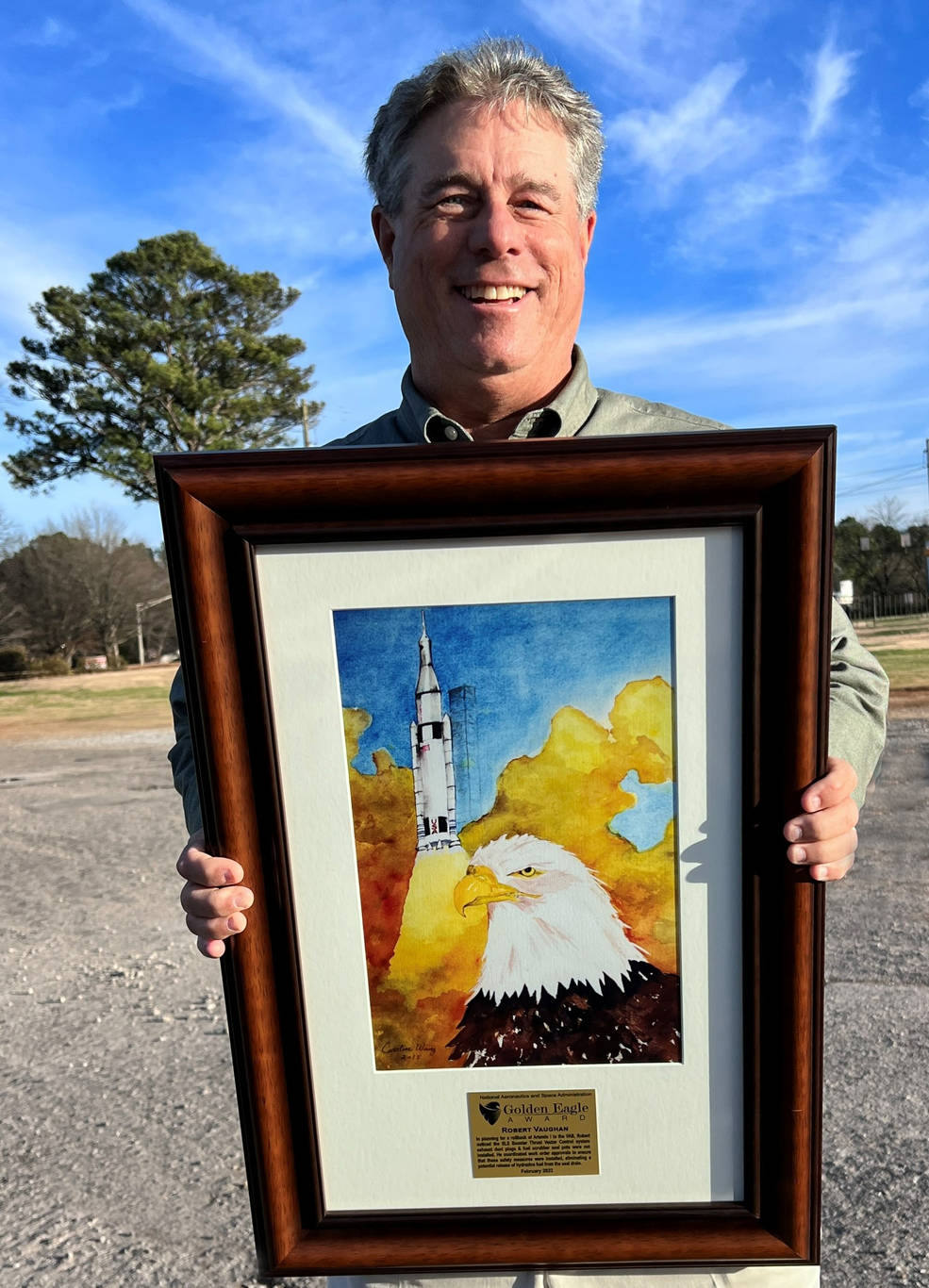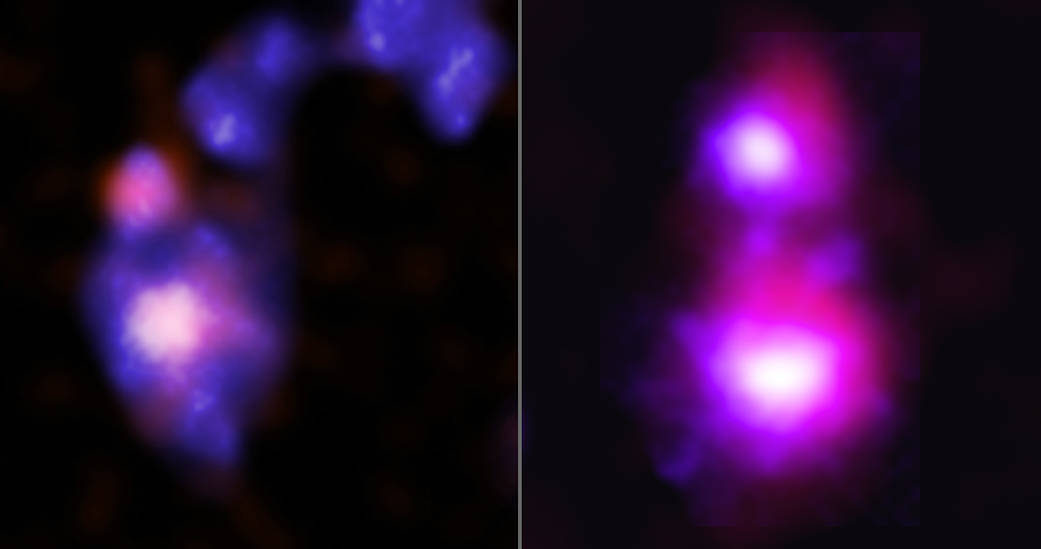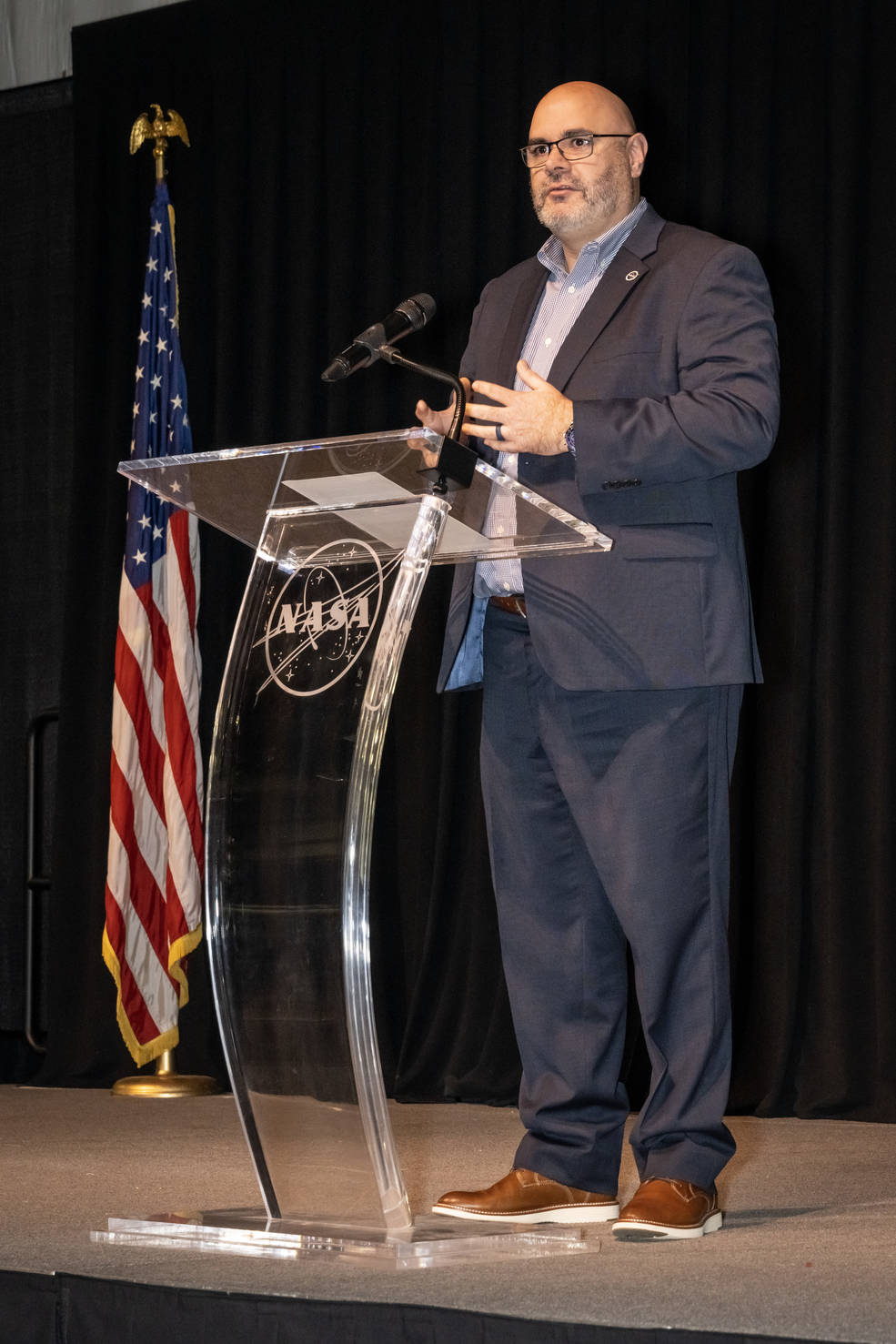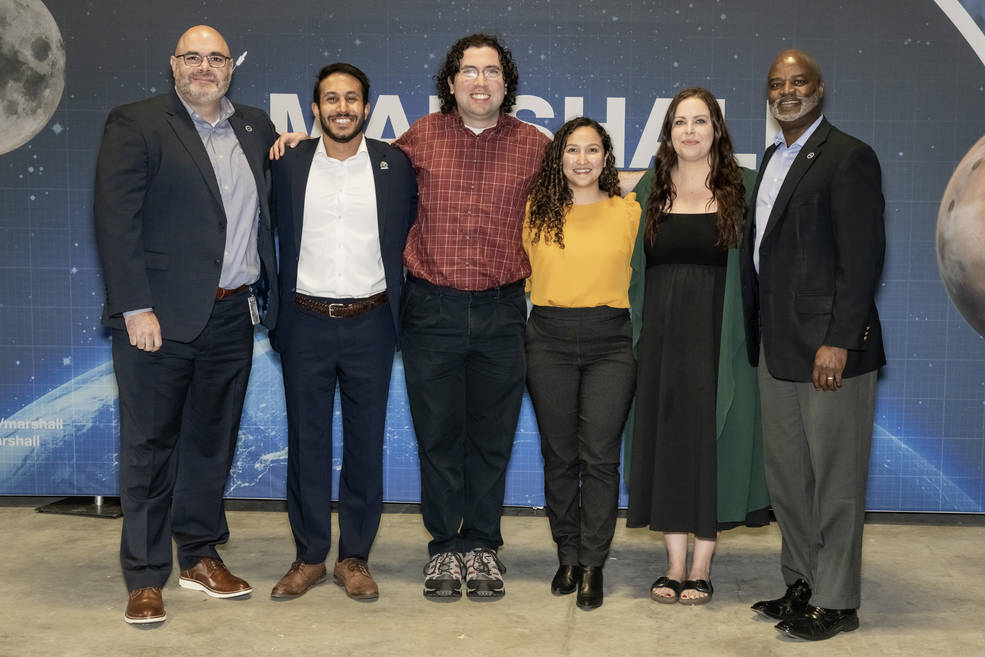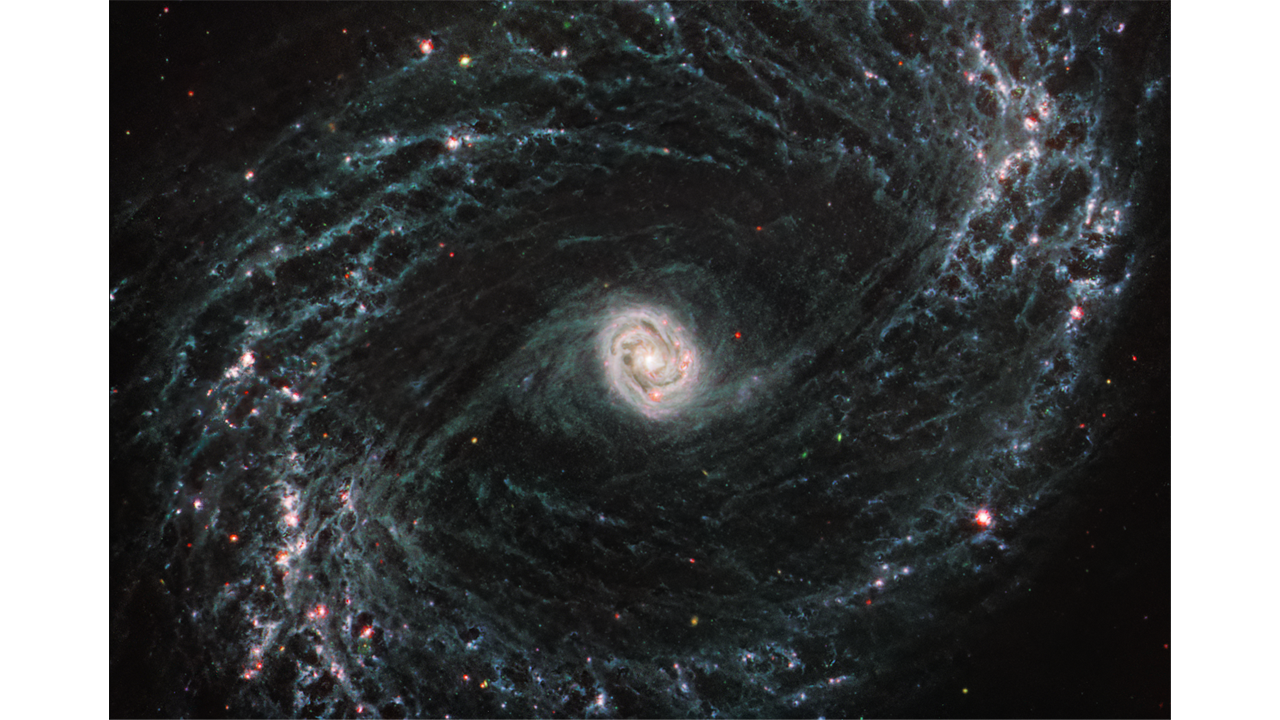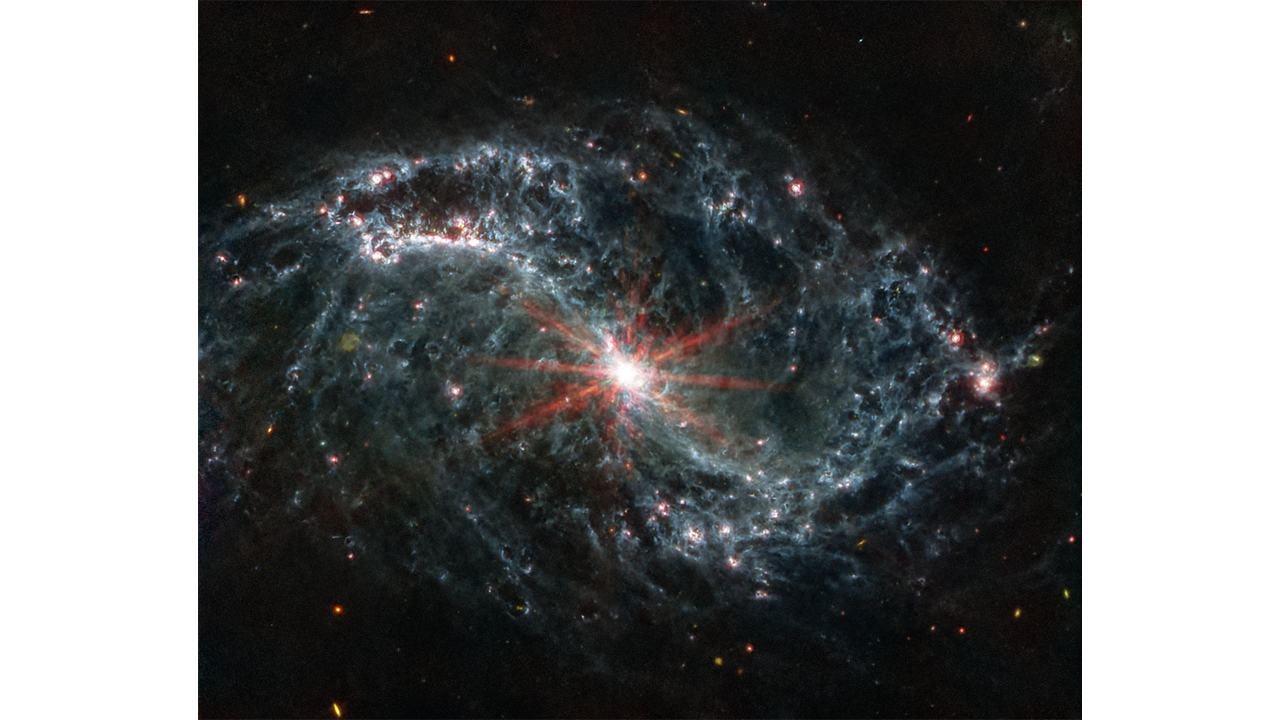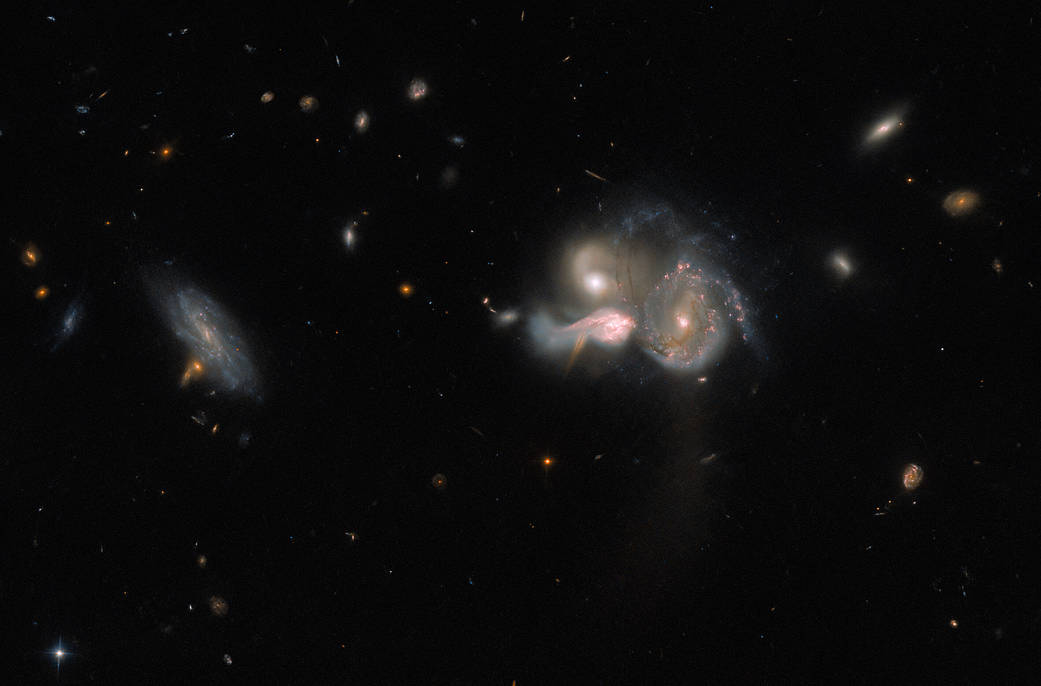The Marshall Star for February 22, 2023.
In This Week’s Star
- Black History Month Profile: LaBreesha Batey
- Black History Program Highlights Huntsville’s Rich Legacy of Leadership
- NASA, SpaceX Move Crew-6 Launch to Feb. 27
- Michoud Marks an Artemis Milestone with Opening of North Gray Box
- Dr. Scott Hubbard Discusses Columbia Shuttle Investigation; Robert Vaughan Receives Golden Eagle Award
- NASA’s Chandra Discovers Giant Black Holes on Collision Course
- MECO Mentoring Event Focuses on Connecting Marshall Team Members
- NASA’s Webb Reveals Intricate Networks of Gas and Dust in Nearby Galaxies
- Hubble Views a Merging Galactic Trio
Black History Month Profile: LaBreesha Batey
Each year, NASA celebrates Black History Month, highlighting the importance of the culture, traditions, and contributions of its African American workforce. The theme of this year’s observance is “#BLACK: Building a Legacy of Achievement, Connection, & Knowledge.”
LaBreesha Batey, program analyst, systems engineer, and project manager/principal investigator in Human Landing System (HLS) at NASA’s Marshall Space Flight Center, shares her career journey and what this month of honor and celebration means to her. Batey also serves as deputy chair of the Women of Excellence Employee Resource Group at Marshall.
Name: LaBreesha Batey
Title: Program analyst, systems engineer, and project manager/principal investigator for Human Landing System program
Hometown: Nashville, Tennessee
Years with NASA:12
My role at NASA: I am a bit of an anomaly, serving in many roles, and I was the first person at Marshall to lead a technical project from a non-technical discipline. I formerly served as a contracting officer/team lead within the Office of Procurement, supporting an array of projects and programs including the Space Launch System (SLS) Booster and SLS Engines programs. Currently, I support HLS by developing and ensuring sound products and deliverables for the fluidity of the program. As a program analyst, I capitalize on my systems engineering and procurement background through succinct coordination and integration of various elements and divisions, including the cost, schedule, technical, management, and risk that impact HLS. I also serve as a project manager/systems engineer/principal investigator at Marshall, over an unprecedented project in which I am investigating a unique material and its potential to fortify our space structures and aid in treating neurological disorders that astronauts experience upon their return from various space missions. In 2021, this project caught the interest of NASA Administrator Bill Nelson, and we had the privilege of including him in our testing. In 2022, we received NASA’s Best Technical Project/Program of the Year Award.
What my work means to me: The work I do for NASA allows me to utilize my diverse background to empower others, contribute to NASA missions in innovative ways, and embark on missions into new territories. Ultimately, it is the ability and opportunity to influence and transform cultures, systems, products, and processes that serves as the most significant part of my work. This is the impetus to my motivation of performing in excellence.
I am highly motivated by results. When I get to hire and positively influence interns and build relationships through HLS and various programs and projects, I am motivated to walk in the realm of excellence, impact, transformation, and influence. My work simply allows me to walk in the very essence of who I am: a change agent.
The people who have influenced my life and career: We never get anywhere in life on our own. I have had many mentors and influencers. My mother, with her self-motivation and many accomplishments, despite enduring chronic pain, has greatly impacted my life and my career. She reminds me that I am not bound by my circumstances and that with determination and faith, my opportunities are limitless.
Others who have impacted me include:
- My professors – Deborah McDonald, Wanda Anglin, and Dr. McDaniel – who sought to encourage me beyond the academic realm by sowing wisdom and advice based on their experiences.
- NASA Leadership – Audrey Robinson, John Dankanich, Ruth Jones, Elaine Duncan, Lisa Watson-Morgan, David Brock, Lakiesha Hawkins, Larry Leopard, and Jody Singer – via their stories of failures and successes, leadership styles, and their render of indirect and direct advice to propel me forward.
- Mentors and connectors – Teresa Foley-Batts, Jannifer Matthews, and Angela Lovelady – who have stressed the importance of mentorship, paying it forward, and surrounding myself with people who can see things for me, even when I can’t see it for myself.
- Those individuals known as the “greats” – Maya Angelou, T.D. Jakes, and Katherine Johnson. Their ability to turn tumultuous occurrences into triumphs, and to utilize such to set a pre-eminence of transformation has greatly impacted me.
What the theme “Building a Legacy of Achievement, Connection, & Knowledge” means to me: Maya Angelou had it right when she said, “When you get, give, when you learn, teach.” Oprah Winfrey also had it right when she said, “There is so much to be gained from what we can give back.” Personifying these quotes in my everyday life and career is exactly what building a legacy of achievement, connection, and knowledge means to me. It is the ability to recognize opportunities in every endeavor I encounter to not only perform the duties well, but to influence, transform, and to pay it forward. Anyone can perform transactional activities as required by a job, but to build a legacy of achievement, connection, and knowledge is to think about how your contributions can enhance knowledge, fortify connections, and impact the next generation.
For me, it is also having the audacity to think and perform outside of the box by maintaining an intellectual curiosity and endeavoring to remain innovative to develop new solutions and create opportunities for generations to come. I’m ecstatic when I think of all the interns I’ve employed. They have diverse backgrounds and skill sets, and many are currently doing remarkable work. They have said my project enlightened and inspired them to pursue these other endeavors. For me, this is the epitome of building a legacy, connection, and knowledge: to impact, inspire, and transform, while in the process of performing duties. This is exactly what Katherine Johnson and Dr. Martin Luther King Jr. sought to do in their intellectualism and activism. Their contributions broke barriers, transformed, influenced, and impacted many generations. I now can see myself in Johnson’s endeavors and what she initiated. To see my impact on interns and to hear stakeholders I’ve supported thank me for paying it forward – this is the evidence I am right in line with those building a legacy.
Black History Program Highlights Huntsville’s Rich Legacy of Leadership
William Hampton, historian and founder of the Huntsville Revisited History Museum, speaks during Marshall’s Black History Month program Feb. 22 in Building 4203. A sixth-generation resident of Huntsville and Madison County, Hampton regaled the hybrid audience with stories of Huntsville’s landmarks, like the historic First National Bank, the original site of Alabama A&M University, and the Black-owned business district that thrived in the 1960s off Church Street. “I developed a love of history as a small child,” said Hampton, who credited his interest in – and now wealth of – historical knowledge to stories passed down from his great-grandparents and grandparents. Hampton highlighted the legacy of Black leaders in Huntsville and northern Alabama: business owners, athletes, educators, authors, freedom seekers, and civil rights leaders. (NASA/Charles Beason)
Carolyn Magsby, deputy director of Marshall Space Flight Center’s Office of Diversity & Equal Opportunity (ODEO), presents William Hampton with a certificate of appreciation for his presentation during the Black History Month program on Feb. 22. Marshall Public Affairs Officer Lance Davis opened the program with a stirring rendition of “Lift Every Voice and Sing,” and following the program, Magsby invited attendees to fellowship while enjoying a sampling of food. “Everyone in here is rich in history,” Magsby said, addressing attendees. “You just have to know your story.” Magsby also presented a certificate of appreciation to Angelia Walker, director of the Spacecraft and Vehicle Systems Department at Marshall who, along with Van Strickland, SLS program operations manager at Marshall, spoke Feb. 16 during a Lunch and Learn event hosted by the Black Employees & Allies of Marshall (BEAM) Resource Group. (NASA/Charles Beason)
NASA, SpaceX Move Crew-6 Launch to Feb. 27
SpaceX Crew-6 astronauts pause for a photograph after arriving at Kennedy Space Center’s Launch and Landing Facility on Feb. 21. From left are Roscosmos cosmonaut Andrey Fedyaev, UAE (United Arab Emirates) astronaut Sultan Alneyadi, and NASA astronauts Warren “Woody” Hoburg and Stephen Bowen. Liftoff for the Crew-6 mission to the International Space Station is slated for Feb. 27 at 12:45 a.m. CST from Kennedy Launch Complex 39A. Managers from NASA and SpaceX, along with international partners, met throughout the day Feb. 21 as part of the mission’s Flight Readiness Review (FRR) in preparation for the sixth crew rotation mission with SpaceX to the microgravity laboratory. The FRR focused on the preparedness of SpaceX’s crew transportation system, the space station, and its international partners to support the flight, as well as the certification of flight readiness. The international crew will fly aboard the SpaceX Crew Dragon spacecraft Endeavour, carried by the company’s Falcon 9 rocket. The Commercial Crew Program (CCP) launch vehicle on-console mission support team at NASA’s Marshall Space Flight Center continues contributing to commercial crew missions, including the Crew-6 mission. Consisting of about 80 people supporting the CCP office, Engineering, and Safety Mission Assurance, the Marshall team members provide management support as well as engineering expertise in propulsion, valves and pyrotechnics, natural environments, vehicle structures, and various other areas. (NASA/Kim Shiflett)
Michoud Marks an Artemis Milestone with Opening of North Gray Box
By Matt Higgins
NASA leadership, partners, elected officials, an astronaut, and team members gathered at NASA’s Michoud Assembly Facility Feb. 13 to celebrate the opening of the North Gray Box, the production and processing area for the Space Launch System’s advanced Exploration Upper Stage (EUS).
Beginning with Artemis IV, EUS will replace the Interim Cryogenic Propulsion Stage on the SLS Block 1B rocket configuration. Its larger fuel tanks and four RL10 engines will send astronauts and large cargos to the Moon.
Attendees gathered at the Hero’s Way stage inside the 43-acre factory at Michoud before the ribbon-cutting ceremony. Speakers on-stage included NASA Associate Administrator, Exploration Systems Development, Jim Free; Vice President of GM Space, Intelligence, and Weapons Systems Kay Sears; Boeing Defense, Space, and Security CEO Ted Colbert; U.S. Rep. Troy Carter (D-La.); and NASA astronaut Stanley G. Love – and highlighted the agency’s investment in Artemis and the part EUS plays in future Artemis missions.
“It’s Boeing’s commitment to continue work at Michoud to put the first woman and first person of color on the Moon,” Sears said.
Those helping cut the ribbon were Free, Sears, Colbert, Carter, SLS Program Manager John Honeycutt, and Louisiana Secretary of Commerce Don Pierson.
Boeing is the SLS prime contractor for the core stage and Exploration Upper Stage. Technicians at Michoud are manufacturing structures for multiple SLS rockets that will power future Artemis flights, including the core stages for Artemis II, III, and IV. Hardware for EUS is in early production. Each element of EUS will be manufactured in the North Gray Box.
Higgins, a Manufacturing Technical Solutions Inc. employee, works in communications at Michoud Assembly Facility.
Dr. Scott Hubbard Discusses Columbia Shuttle Investigation; Robert Vaughan Receives Golden Eagle Award
Dr. Scott Hubbard addresses attendees during the Mission Success is in Our Hands virtual Shared Experiences Forum on Feb. 16. His presentation was entitled “Ambition and Risk: The Columbia Shuttle Tragedy.” This year marks the 20th anniversary of the Columbia accident, in which seven astronauts died upon the shuttle’s re-entry into Earth’s atmosphere. Hubbard, who was director of NASA’s Ames Research Center at the time, spent seven months on the Columbia Accident and Investigation Board. “Prior to my service on the Columbia board, I had been to numerous launches, some involving my own programs, and I felt the power and the awe when that vibration comes and liftoff occurs and you see all the power of the launch vehicle,” Hubbard said. “But after my service, not only did I feel that awe, but if there were human beings involved, I realized the risk they are taking and the unspoken agreement we have; that we’re going to do everything we can to launch and return that crew safely.” Hubbard now chairs the SpaceX Commercial Crew Safety Advisory Panel. He is also the former director of NASA’s Mars Program and the agency’s Astrobiology Institute, and he created Stanford University’s Center of Excellence for Commercial Space Transportation. A video of Hubbard’s presentation will be uploaded here. Mission Success is in Our Hands is a safety initiative collaboration between NASA’s Marshall Space Flight Center and Jacobs Engineering. (NASA)
Prior to Hubbard’s presentation, Robert Vaughan was named the 36th recipient of the Golden Eagle Award. Vaughan, a Jacobs Space Exploration Group employee, works in the Space Launch System (SLS) Boosters Office as part of the Engineering Services and Science Capability Augmentation contract. He was honored for coordinating a vehicle configuration change to ensure safe rollback of SLS to the Vehicle Assembly Building at NASA’s Kennedy Space Center ahead of Hurricane Ian’s landfall in September 2022. Since 2015, the Golden Eagle Award has been presented by Mission Success is in Our Hands. The award promotes awareness and appreciation for flight safety, as demonstrated through the connections between employees’ everyday work, the success of NASA and Marshall’s missions, and the safety of NASA astronauts. The award recognizes individuals who have made significant contributions to flight safety and mission assurance above and beyond their normal work requirements. Management or peers can nominate any team member for the award here. Honorees are typically recognized at quarterly Shared Experiences forums. (NASA)
NASA’s Chandra Discovers Giant Black Holes on Collision Course
A new study using NASA’s Chandra X-ray Observatory has tracked two pairs of supermassive black holes in dwarf galaxies on collision courses, as discussed in this press release. This is the first evidence for such an impending encounter, providing scientists with important information about the growth of black holes in the early Universe.
By definition, dwarf galaxies contain stars with a total mass less than 3 billion Suns – or about 20 times less than the Milky Way. Astronomers have long suspected that dwarf galaxies merge, particularly in the relatively early Universe, in order to grow into the larger galaxies seen today. However, current technology cannot observe the first generation of dwarf galaxy mergers because they are extraordinarily faint at their great distances. Another tactic – looking for dwarf galaxy mergers closer by – had not been successful to date.
The new study overcame these challenges by implementing a systematic survey of deep Chandra X-ray observations and comparing them with infrared data from NASA’s Wide Infrared Survey Explorer (WISE) and optical data from the Canada-France-Hawaii Telescope (CFHT).
Chandra was particularly valuable for this study because material surrounding black holes can be heated up to millions of degrees, producing large amounts of X-rays. The team searched for pairs of bright X-ray sources in colliding dwarf galaxies as evidence of two black holes, and discovered two examples.
One pair is in the galaxy cluster Abell 133 located 760 million light-years from Earth, seen in the composite image on the left. Chandra X-ray data is in pink and optical data from CFHT is in blue. This pair of dwarf galaxies appears to be in the late stages of a merger, and shows a long tail caused by tidal effects from the collision. The authors of the new study have nicknamed it “Mirabilis” after an endangered species of hummingbird known for their exceptionally long tails. Only one name was chosen because the merger of two galaxies into one is almost complete. The two Chandra sources show X-rays from material around the black holes in each galaxy.
The other pair was discovered in Abell 1758S, a galaxy cluster about 3.2 billion light-years away. The composite image from Chandra and CFHT is on the right, using the same colors as for Mirabilis. The researchers nicknamed the merging dwarf galaxies “Elstir” and “Vinteuil,” after fictional artists from Marcel Proust’s “In Search of Lost Time”. Vinteuil is the galaxy on the top, and Elstir is the galaxy on the bottom. Both have Chandra sources associated with them, again from X-rays from material around the black holes in each galaxy. The researchers think these two have been caught in the early stages of a merger, causing a bridge of stars and gas to connect the two colliding galaxies from their gravitational interaction.
The details of merging black holes and dwarf galaxies may provide insight to our Milky Way’s own past. Scientists think nearly all galaxies began as dwarf or other types of small galaxies and grew over billions of years through mergers. Follow-up observations of these two systems will allow astronomers to study processes that are crucial for understanding galaxies and their black holes in the earliest stages of the Universe.
A paper describing these results is available here. The authors of the study are Marko Micic, Olivia Holmes, Brenna Wells, and Jimmy Irwin, all from the University of Alabama.
NASA’s Marshall Space Flight Center manages the Chandra program. The Smithsonian Astrophysical Observatory’s Chandra X-ray Center controls science operations from Cambridge, Massachusetts, and flight operations from Burlington, Massachusetts.
MECO Mentoring Event Focuses on Connecting Marshall Team Members
Joseph Pelfrey, deputy director at NASA’s Marshall Space Flight Center, delivers opening remarks during the Marshall Early Career Organization (MECO) hybrid mentoring event Feb. 21. The MERGE (Mentoring Employees to Realize Goals and Experiences) Match launch meeting walked attendees through how to create a profile in MERGE Match, followed by table mentoring sessions. MERGE aims to connect early-, mid-, and late-career Marshall professionals to foster professional growth. The MERGE Match app is a networking tool that opens the door to mentoring in areas such as leadership, technical skill growth and work/life balance. “Mentoring is a key component of our center’s future,” Pelfrey said. “These events are a great opportunity to further yourself, make those connections, and further your network. This new MERGE tool is a going to be critical to helping our workforce make those connections and find mentors.” (NASA/Mick Speer)
Pelfrey with Jaysal Shah, John Inness, Marissa Garcia, Lyndsey Winslette, and Larry Mack, deputy director of Marshall’s Office of Human Capital, at the Feb. 21 mentoring event. (NASA/Mick Speer)
NASA’s Webb Reveals Intricate Networks of Gas and Dust in Nearby Galaxies
Researchers using NASA’s James Webb Space Telescope are getting their first look at star formation, gas, and dust in nearby galaxies with unprecedented resolution at infrared wavelengths. The data has enabled an initial collection of 21 research papers that provide new insight into how some of the smallest-scale processes in our universe – the beginnings of star formation – impact the evolution of the largest objects in our cosmos: galaxies.
The largest survey of nearby galaxies in Webb’s first year of science operations is being carried out by the Physics at High Angular resolution in Nearby Galaxies (PHANGS) collaboration, involving more than 100 researchers from around the globe. The Webb observations are led by Janice Lee, Gemini Observatory chief scientist at the National Science Foundation’s NOIRLab and affiliate astronomer at the University of Arizona in Tucson.
The team is studying a diverse sample of 19 spiral galaxies, and in Webb’s first few months of science operations, observations of five of those targets – M74, NGC 7496, IC 5332, NGC 1365, and NGC 1433 – have taken place. The results are already astounding astronomers.
“The clarity with which we are seeing the fine structure certainly caught us by surprise,” said team member David Thilker of Johns Hopkins University in Baltimore, Maryland.
“We are directly seeing how the energy from the formation of young stars affects the gas around them, and it’s just remarkable,” said team member Erik Rosolowsky of the University of Alberta, Canada.
The images from Webb’s Mid-Infrared Instrument (MIRI) reveal the presence of a network of highly structured features within these galaxies – glowing cavities of dust and huge cavernous bubbles of gas that line the spiral arms. In some regions of the nearby galaxies observed, this web of features appears built from both individual and overlapping shells and bubbles where young stars are releasing energy.
“Areas which are completely dark in Hubble imaging light up in exquisite detail in these new infrared images, allowing us to study how the dust in the interstellar medium has absorbed the light from forming stars and emitted it back out in the infrared, illuminating an intricate network of gas and dust,” said team member Karin Sandstrom of the University of California, San Diego.
The high-resolution imaging needed to study these structures has long evaded astronomers – until Webb came into the picture.
“The PHANGS team has spent years observing these galaxies at optical, radio, and ultraviolent wavelengths using NASA’s Hubble Space Telescope, the Atacama Large Millimeter/Submillimeter Array, and the Very Large Telescope’s Multi Unit Spectroscopic Explorer,” added team member Adam Leroy of the Ohio State University. “But, the earliest stages of a star’s lifecycle have remained out of view because the process is enshrouded within gas and dust clouds.”
Webb’s powerful infrared capabilities can pierce through the dust to connect the missing puzzle pieces.
For example, specific wavelengths observable by MIRI (7.7 and 11.3 microns) and Webb’s Near-Infrared Camera (3.3 microns) are sensitive to emission from polycyclic aromatic hydrocarbons, which play a critical role in the formation of stars and planets. These molecules were detected by Webb in the first observations by the PHANGS program.
Studying these interactions at the finest scale can help provide insights into the larger picture of how galaxies have evolved over time.
Because these observations are taken as part of what’s called a treasury program, they are available to the public as they are observed and received on Earth,” said Eva Schinnerer of the Max Planck Institute for Astronomy in Heidelberg, Germany, and leader of the PHANGS collaboration.
The PHANGS team will work to create and release data sets that align Webb’s data to each of the complementary data sets obtained previously from the other observatories, to help accelerate discovery by the broader astronomical community.
“Thanks to the telescope’s resolution, for the first time we can conduct a complete census of star formation, and take inventories of the interstellar medium bubble structures in nearby galaxies beyond the Local Group,” Lee said. “That census will help us understand how star formation and its feedback imprint themselves on the interstellar medium, then give rise to the next generation of stars, or how it actually impedes the next generation of stars from being formed.”
The research by the PHANGS team is being conducted as part of General Observer program 2107. The team’s initial findings, comprised of 21 individual studies, were recently published in a special focus issue of The Astrophysical Journal Letters.
The James Webb Space Telescope is the world’s premier space science observatory. Webb will solve mysteries in our solar system, look beyond to distant worlds around other stars, and probe the mysterious structures and origins of our universe and our place in it. Webb is an international program led by NASA with its partners, ESA (European Space Agency), and CSA (Canadian Space Agency).
Hubble Views a Merging Galactic Trio
A spectacular trio of merging galaxies in the constellation Boötes takes center stage in this image from the NASA/ESA Hubble Space Telescope. These three galaxies are set on a collision course and will eventually merge into a single larger galaxy, distorting one another’s spiral structure through mutual gravitational interaction in the process. An unrelated foreground galaxy appears to float serenely near this scene, and the smudged shapes of much more distant galaxies are visible in the background. This colliding trio – known to astronomers as SDSSCGB 10189 – is a relatively rare combination of three large star-forming galaxies lying within only 50,000 light-years of one another. While that might sound like a safe distance, for galaxies they are extremely close neighbors. Earth’s galactic neighbors are much further away; Andromeda, the nearest large galaxy to the Milky Way, is more than 2.5 million light-years away from Earth. This image comes from an observation designed to help astronomers understand the origin of the largest, most massive galaxies in the universe. These galactic behemoths are called Brightest Cluster Galaxies (BCGs) and – as the name suggests – are defined as the brightest galaxies in any given galaxy cluster. Astronomers suspect that BCGs form through the merger of large, gas-rich galaxies like the ones seen here. They turned to Hubble’s Wide Field Camera 3 and Advanced Camera for Surveys to investigate this galactic trio in painstaking detail, hoping to shed light on the formation of the universe’s most massive galaxies. (ESA/Hubble & NASA, M. Sun)


























